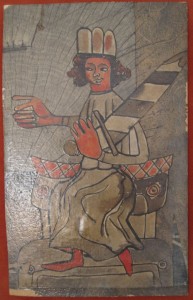(Click to Enlarge)
Mixed media consisting of halftone prints, ink, ink wash, and what appears to be gouache on thin cardboard
7 x 4 1/4 inches
Signed lower left
Brilliant colors with loss and rising in paper
Sat in early 20th century frame behind glass and velvet matte which will be provided with artwork.
Last origin: Milwaukee, WI
An antique German American or German expressionist measuring approximately 7 x 4 1/4 inches. Note the upper right with original artwork blended with the halftone print. This is the most intriguing mixed media artwork I have owned and research is ongoing. It has influence by Max Beckmann and Hannah Hoch. Signed lower left; contact gallery for photo of signature. Last origin was Milwaukee, WI and possibly done by a German American immigrant or by a German. This is possibly an allegorical piece done in the Weimar Republic in 1918 or slightly earlier depicting the strong hand of the overthrow of German Imperial government and Emperor Wilhem II. This piece could be classified as Dada “degenerate art” piece. The German Revolution or November Revolution (German: Novemberrevolution) was the politically driven civil conflict in the German Empire at the end of the First World War, which resulted in the replacement of Germany’s imperial government with a republic. The revolutionary period lasted from November 1918 until the establishment in August 1919 of a republic (which later became known as the Weimar Republic). The roots of the revolution lay in the German Empire’s fate in the First World War and the social tensions which came to a head shortly thereafter. The first acts of revolution were triggered by the policy of the Supreme Command and its lack of coordination with the Naval Command which, in the face of defeat, nevertheless insisted on ordering a climactic battle with the British Royal Navy which never took place. The Wilhelmshaven mutiny (a sailors’ revolt) ensued in the naval ports of Wilhelmshaven and Kiel on 29 October 1918, and the spirit of rebellion spread across the country and led to the proclamation of a republic on 9 November 1918. Shortly thereafter Emperor Wilhelm II abdicated. With the rise of Nazism and the ascent to power of Adolf Hitler in 1933, many German intellectuals and cultural figures, both Jewish and non-Jewish, fled Germany for the United States, the United Kingdom, and other parts of the world. (wiki)




